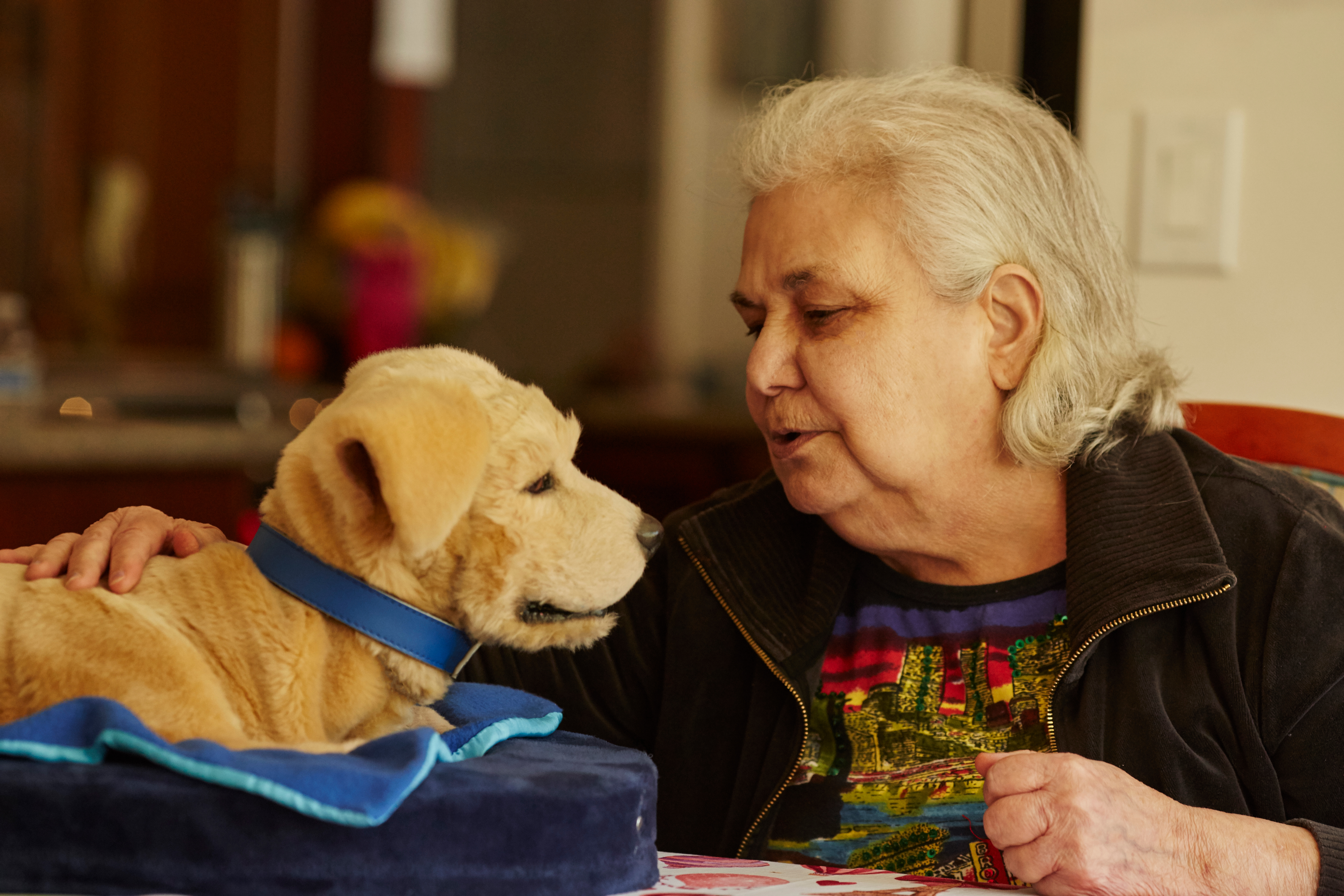Smart technology and home devices helping older adults live independently

Technology is making it easier for older adults to live independently and age in place. From smart home technology such as thermostats and medication boxes to personal emergency response systems and mobility aids, there are many innovations designed to enhance safety, independence, and quality of life. With the right devices and support, you can enjoy more freedom while staying safe and well cared for at home.
As a kid it often felt like the future would have all sorts of exciting technology, such as flying cars, commercial travel to the moon, and hologram communication. While none of that exists quite yet, there’s still a lot of technology that can help you in your life.
That’s especially true if you choose to age in place. Smart technology can offer all kinds of benefits and support to help you live independently.
Whether you're looking to improve safety or enhance daily routines, there's a solution out there that can help. We’re here to help you find the tools that will make a difference in your journey.
How technology supports aging in place
We understand how important it is to maintain your independence as you age — while also feeling safe, supported, and confident at home. Smart home technology, mobility aids, and advanced medical tools can make daily life more comfortable and manageable.
These tools aren’t just about convenience — they’re about helping you stay in control. With the right technology, you can feel more secure in your routine and more confident in your ability to care for yourself on your own terms.
The current generation of “smart” devices can improve:
Safety – Home cameras and security systems can help you feel more secure without sacrificing your privacy. It’s not about being watched — it’s about giving your loved ones a way to check in and make sure you’re OK, especially in case of an emergency. Many systems also connect directly to emergency responders, so help can come quickly if it’s ever needed.1
Independence – As your needs change, certain devices can make daily living more comfortable and help you stay independent. Smart thermostats can keep your home at the right temperature without any hassle. Smart medication boxes can help you stay on track with your prescriptions and avoid taking more than needed. And lift chairs or stair lifts can make it easier and safer to move around your home.
Simply put, technology can be a helpful tool to support your safety and independence, allowing you to continue living comfortably at home for as long as you’d like. It’s normal to have some concerns or fears about new technology — many people do. But today’s devices are designed to be user-friendly and non-intrusive, and there’s often someone in your life who can walk you through how they work. With a little guidance and the right tools, you can feel more confident using technology on your own terms.
7 devices helping older adults on the aging journey
When it comes to planning for the future, it’s completely normal to feel unsure about where to begin. To help you get started, here are seven technologies that can support you living independently:
1. Personal emergency response systems
Personal emergency response systems (PERS), like Life Alert, have been around for years, but they’ve come a long way in terms of technology and reliability. These devices can offer peace of mind for both you and your loved ones, knowing that help is just a button away in case of an emergency.
However, with new innovations come more options — and with more options, it can be hard to decide which system is the best fit. As you explore personal emergency response systems, it's important to consider a few key factors to ensure you choose the right one for your needs:
Fall detection – Some devices can detect when the wearer falls using advanced sensors and accelerometers.2 If you are at risk of falling, consider devices with this function.
Home vs. mobile – While some personal emergency response systems only work at home (or while connected to Wi-Fi), others will use mobile data and GPS tracking to provide support on the go.3 For those with an active lifestyle, this technology for older adults is a must.
Waterproofing – Luckily, many of today’s systems are waterproof. This is an especially important feature if you bathe yourself or exercises outdoors.
While personal emergency response systems have been on the market for years, today’s personal security devices offer advanced functionality that can support safety and independence for older adults.
2. Smart medication boxes
Smart medication boxes are an exciting in-home medication management system innovation, especially for older adults and their care circles.
While different models offer unique functions, many of these devices:4
Provide packaged doses – Some smart medication boxes provide prepackaged pouches of pills at scheduled times. While these pouches need to be packed by a caregiver or pharmacist, they still offer a lower-risk alternative for older adults.
Give reminders – Many smart medication boxes make sounds or even send a notification to a smartphone when it’s time to take medications. You can even set some devices to provide reminders for medications that don’t necessarily work for the “pill case” format: liquids, injections, and inhalers, for instance.
Prevent double dosing – Perhaps most importantly, smart medication boxes prevent double dosing (at least for room temperature-stable pills). By logging doses, providing reminders, and preventing manual access to medications, they can help you take medications as directed.
The last point above is critical: Double dosing is a well-documented risk for older adults, and “overmedication” can lead to falls, vehicle accidents, and other dangers.5
Smart medication boxes can help eliminate doubt and support safe dosing for older adults receiving care.
3. Camera systems
We’ve already touched on a few of the benefits of camera security systems — such as improving home safety, connecting to emergency services, and allowing others to check in when needed. But there are other ways these tools can support your comfort and peace of mind:
Reducing fall-related worries – If you’re at greater risk of falling — whether from natural changes in balance or side effects from medication — certain camera systems can send movement alerts to someone you trust. This way, they’ll know when you’re up and active, just in case you need support.
Support quality of life for hard-of-hearing adults – If you sometimes have trouble hearing the doorbell, a video doorbell connected to your smartphone can help. It’s a simple way to make sure you don’t miss important visitors or deliveries.
Offering a backup communication option – Some camera systems have a “talkback” feature that allows people to speak with you through the camera using their phone. If your cell phone ever runs out of battery or gets misplaced, this can be a handy backup way to stay connected.
Of course, your privacy matters. If you’re considering using an indoor camera, it’s important to choose one that you feel comfortable with. You’re in control — talk through your preferences with loved ones so everyone’s on the same page.
4. Communication aids
As hearing naturally changes with age, it’s completely normal to look for ways to stay connected and engaged. The good news is, there are modern tools that can help you communicate more easily and improve your quality of life — without feeling left out or isolated:
Hearing aids and implants – From conventional over-the-ear hearing aids (for moderate hearing loss) to cochlear implants (for profound hearing loss), today’s assistive devices can make it easier for older adults to stay connected to the world despite diminishing hearing.6,7
Talk-detect devices and apps – While captioned landline phones are not a new development, this functionality is now available on smartphones. Captioning apps for mobile phones capture speech on the other line and transcribe it into text — some can even identify different speakers and note background sounds.8
Hearing loss can sometimes make independent living more challenging, especially when it affects your ability to hear alarms, conversations, or the doorbell. But with the right communication tools, you can stay connected to others — and to your environment — in safe and meaningful ways.
5. WanderGuard systems
WanderGuard systems can serve a few important purposes when it comes to supporting your safety:9
Trackers provide in-depth location information for anyone wearing a device.
Monitors provide alerts when tracking devices move beyond approved “zones.”
Devices can also provide alerts when windows and doors open.
WanderGuard systems aren’t something every older adult needs, but they can be particularly helpful for those experiencing memory changes — especially if there’s a tendency to wander or leave the home unexpectedly.
The great thing about WanderGuard systems is that they’re customizable to fit your needs. Whether you enjoy spending time in your garden and want to ensure you’re safe while outside, or if you need alerts on doors throughout your home, these systems can be adjusted as your situation changes.
6. Smart appliances and accessories
Smart home technology is not just for younger adults — it can be a great fit for your home as well. If a device proves helpful in someone else’s home, chances are it could be just as beneficial for you.
There are a variety of smart appliances and health accessories designed to make life easier and more enjoyable. Some examples include:
Robot vacuums – Small, rechargeable vacuums that eliminate the need for large, heavy models
Smart thermostats – Thermostats that can be programmed to set temperatures based on triggers (e.g., time of day, indoor temperature, outdoor conditions)
Smart lights – App-controlled or voice-activated light bulbs and fixtures that can be scheduled to turn on and off, dim, or change color
Smart security systems – Networks of devices that monitor indoor movement, automatically lock doors, and alert emergency services when needed
Remote cooking devices – Slow cookers, air fryers, and other countertop appliances that can be remotely controlled from a smartphone (that caretakers can use to make sure devices are turned off, for instance)
7. Mobility devices
Just as hearing technologies help those with hearing loss stay connected, mobility devices can make it easier and safer for you to move around at home, even if your mobility has changed.
If you’re looking for ways to stay active and independent despite limited mobility, consider:
Lift chairs – Recliners and sofas that provide leg and back support while standing and sitting
Electric beds – Beds with adjustable positioning that can double as armchairs or recliners and help those with trouble standing independently
Power wheelchairs – Battery-powered wheelchairs that can support normal functioning without the physical demands of a conventional wheelchair
How to set up smart technology for older adults
You might be thinking, “I’m not ready to start using a smart thermostat,” and that’s completely understandable. If you’re open to incorporating some technology into your daily life, here are a few tips to make the process easier and more comfortable:
Prioritize automation – For those who are hesitant about technology, choose devices that require minimal interaction. For example, a thermostat that automatically adjusts the temperature without needing to be manually controlled can make life more comfortable without adding complexity.
Start small – It’s best to introduce new technology one step at a time. You don’t have to install everything at once. Start with a robot vacuum, move to voice-controlled lights, try a simple phone for older adults, and save devices with higher learning curves (like doorbell cameras) for last.
Lean on your care network for support – You don’t have to do it alone. Your health care team, family members, or even home care professionals can be there to help you get familiar with these devices and show you how they can improve your daily life.
Looking for support that goes beyond technology?
Smart technology is great, but sometimes your care needs require a human touch. Search the CareScout Quality Network to find a quality provider near you.






